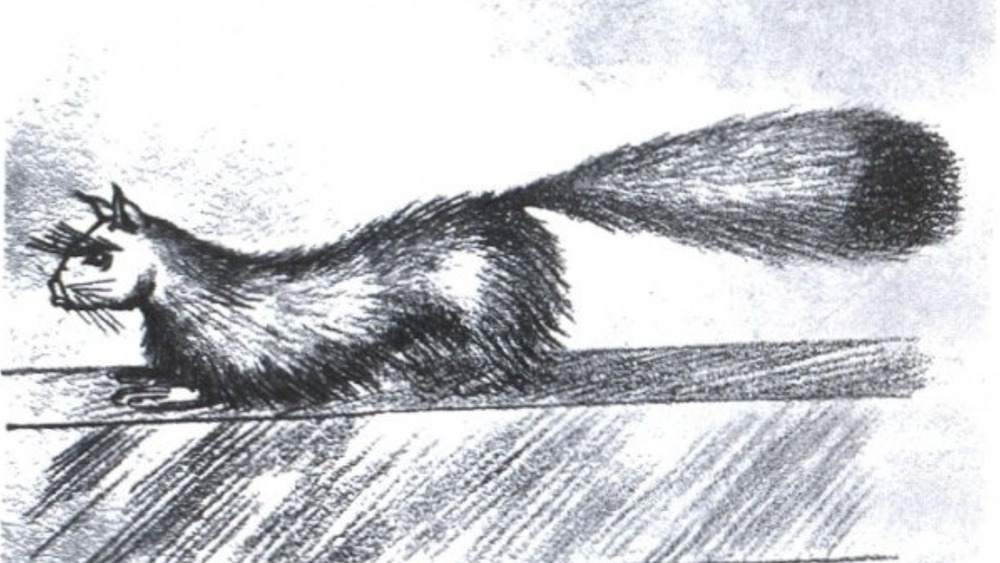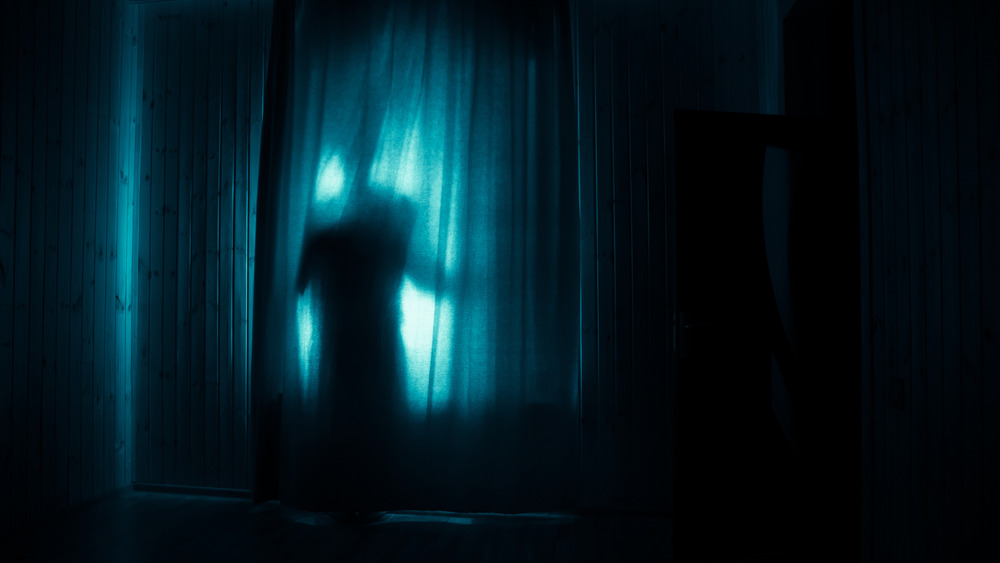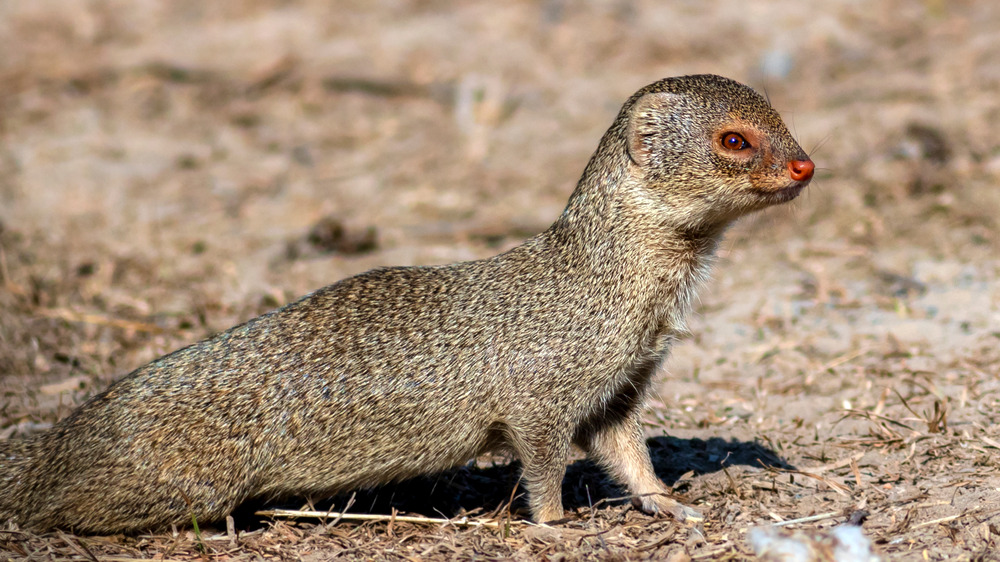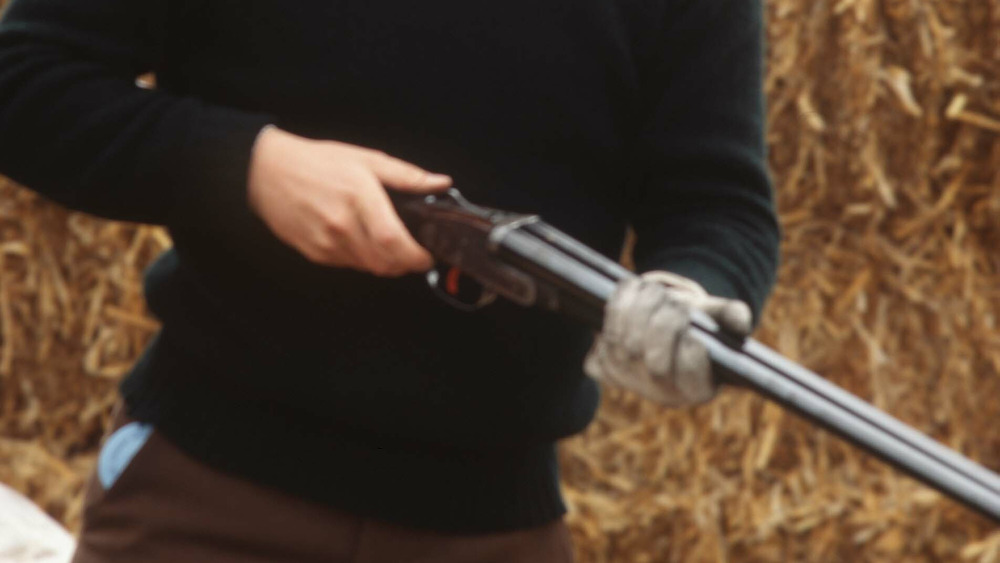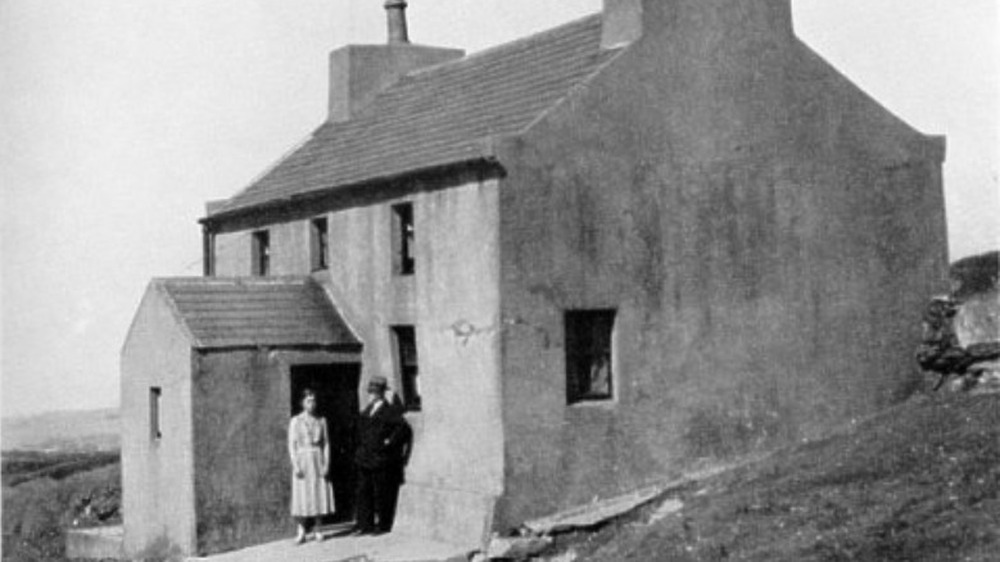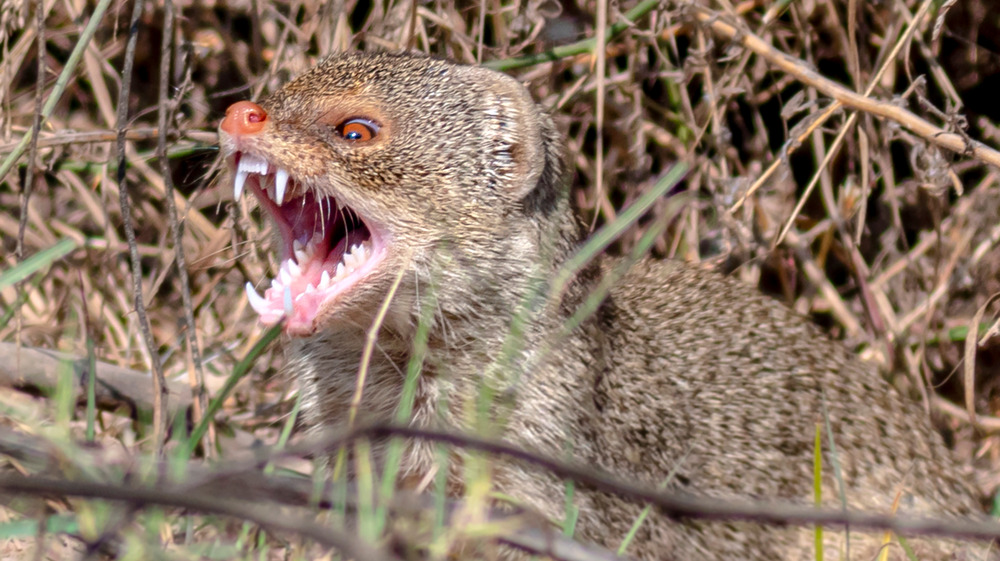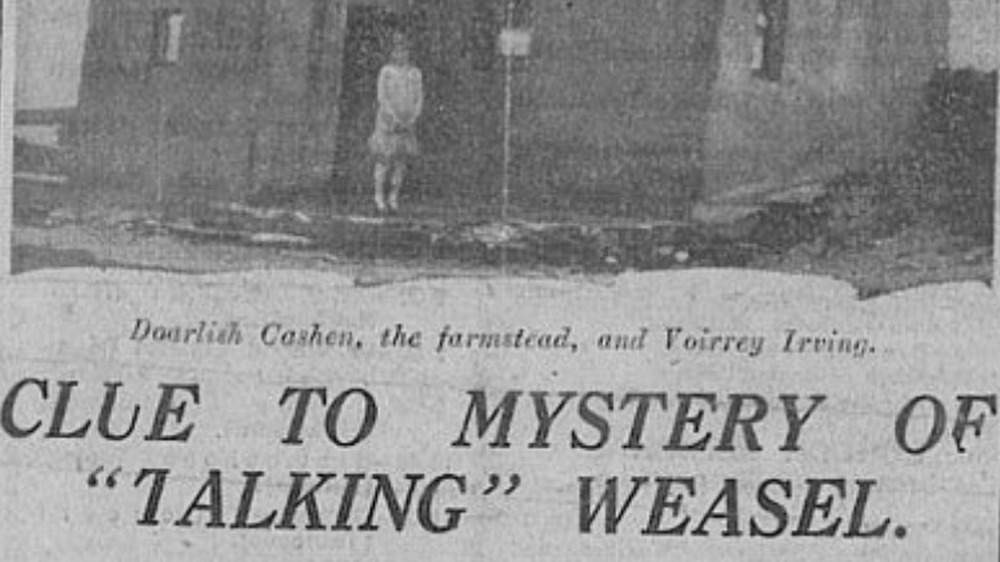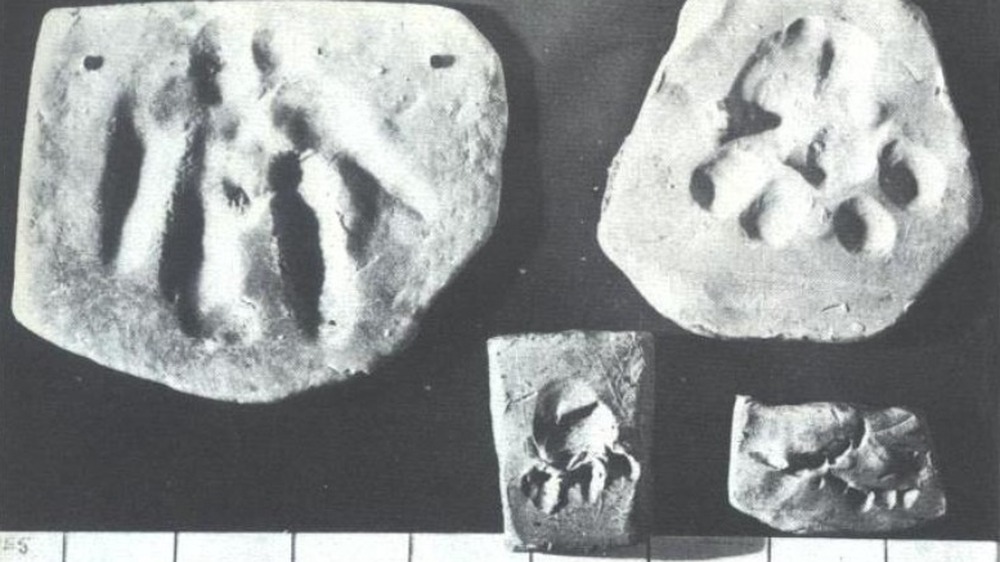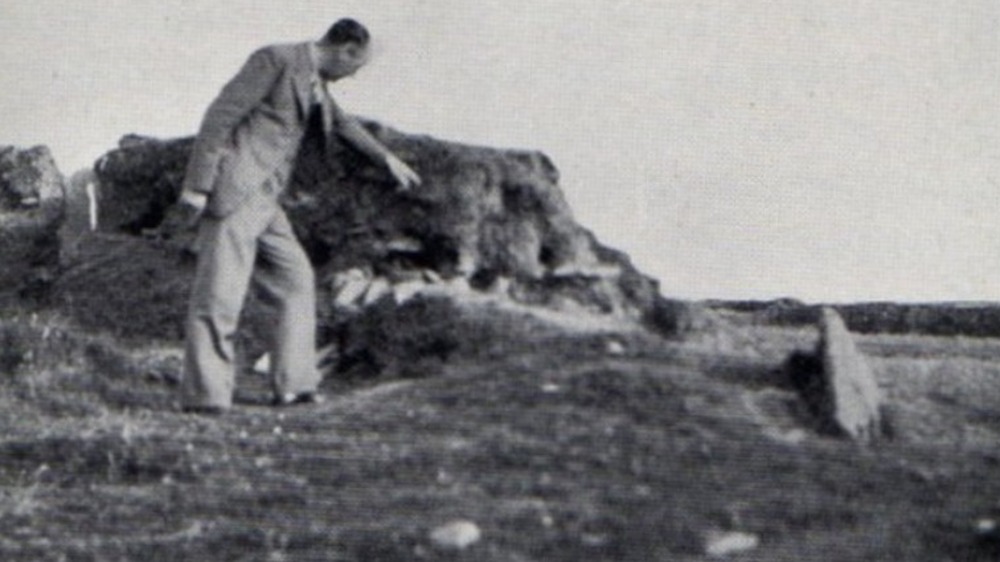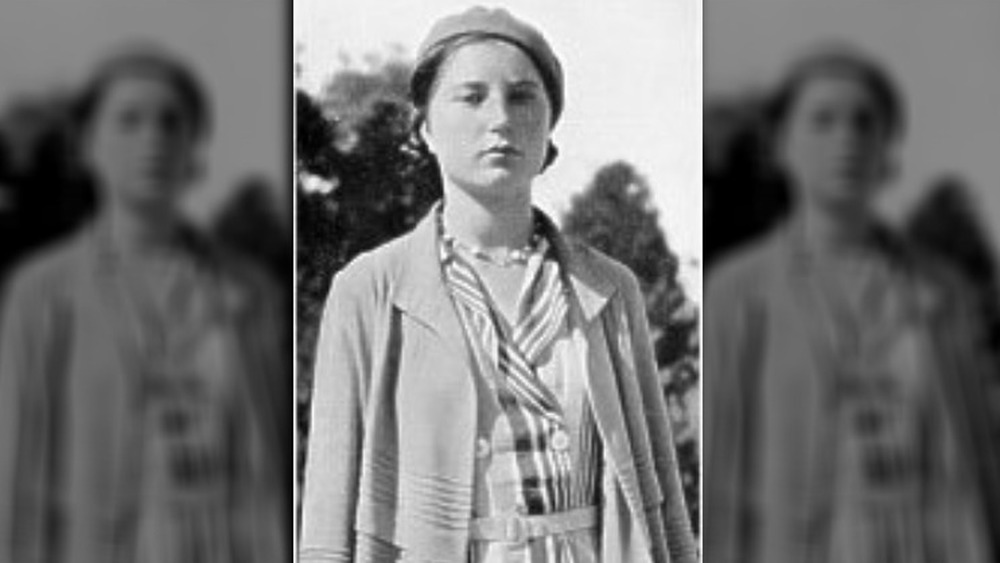The Bizarre True Story Of Gef The Talking Mongoose
While not as well known as the Amityville Horror, the Bell Witch of Tennessee, or Annabelle the haunted doll, the case of Gef the talking mongoose is nonetheless one of the most bizarre incidents in paranormal history. Combining elements of poltergeist activity and the cryptozoological, the story of Gef caught the attention of the British tabloid press in the early 1930s near the end of a worldwide surge in interest in spiritualism, the occult, and the supernatural. For a brief time, Gef took the world of Fortean studies by storm as some of the greatest ghost hunters of the day descended on the home of farmer James Irving to get a glimpse of the peculiar creature.
Also known as the Dalby Spook, Gef was allegedly an intelligent entity that claimed to be a ghost in the form of a mongoose, a small carnivorous mammal native to India, Africa, and Southern Europe. Endowed with the gift of speech, Gef was alternately a helpmate and an annoyance to Irving, his wife Margaret, and their young daughter Voirrey, who lived in a centuries-old stone house known as Doarlish Cashen near the town of Dalby on Britain's Isle of Man.
Although Gef would disappear with the Irvings' departure from Doarlish Cashen, interest in the incident has persisted for decades. Whether Gef was a hoax, the product of a bored child's active imagination, or something else remains a topic of debate for scholars of the paranormal into the 21st century.
The Irving family and the mysterious farmhouse
As documented by author Christopher Josiffe in his 2017 book, Gef! The Strange Tale of an Extra-Special Talking Mongoose, James Irving and his wife, Margaret, moved into Doarlish Cashen (translated from Manx Gaelic as Cashen's Gap) in 1917. Irving, a native of Liverpool, had been a successful agent for Dominion Organ and Piano before a change in fortunes necessitated a change in career. After failed forays into engineering and the property market, Irving, with no prior experience, decided to become a farmer. He purchased the old stone house near the hamlet of Dalby and embarked on a new, hardscrabble life on the Isle of Man.
Although Irving, an amateur antiquarian, maintained that Doarlish Cashen was only 130 years old at the time of his purchase of the stone farmhouse, Josiffe suggests that its location, dry-stone construction, and size indicated that it was far older, perhaps dating to medieval times. Manx history and folklore suggests that an even older structure existed on or near Doarlish Cashen's location. Less than 300 yards from the house's former site (the home was demolished in the early 1970s), lies a prehistoric burial mound. The remains of a Bronze Age cairn circle and a Norse burial ground have also been located in Doarlish Cashen's vicinity.
According to Culture Vannin, a website dedicated to preserving Manx culture, Doarlish Cashen had a reputation for supernatural occurrences, including the stories of strange animals haunting the grounds long before Irving's purchase of the property.
A favor from a friendly ghost?
The so-called Dalby Spook's interaction with the Irving family began in earnest in 1931. However, signs of paranormal activity within Doarlish Cashen were present as early as James Irving's 1917 purchase of the farmhouse. As detailed in Gef! The Strange Tale of an Extra-Special Talking Mongoose, prior to the family taking up residence in the home, Irving hired two workmen from Peel, located approximately nine miles from Doarlish Cashen, to make repairs on the house. Distance necessitated the workers staying overnight in the house. On the second night, Irving encountered the men leaving Doarlish Cashen for Peel. Explaining that they had a small job to complete in their hometown, the workman stated they would return in the morning. Nearly two decades later, Irving learned from the widow of one of the men that strange noises and an overall feeling of the uncanny sent the pair fleeing from the house.
According to James Kerr of The Sunday Tribune Online, the creature that would come to be known as the Dalby Spook first made its presence known in 1931 when the Irvings' 12 year-old daughter, Voirrey, was sent into the fields to snare rabbits for the family's evening meal. To her astonishment, she would find the job had already been done for her with several cleanly killed rabbits left for her as a gift from an apparently friendly "ghost." Soon after, the Irvings began to hear strange, animalistic vocalizations and rustlings emanating from inside the walls of Doarlish Cashen.
Gef speaks!
As detailed by The Fortean Times, the Irvings noticed an animal that appeared to be a weasel in their farmyard in the autumn of 1931. Despite the presence of what would seem to be a notoriously vicious predator, the Irvings' chickens were completely undisturbed by the yellowish, bushy-tailed creature. Noting the strange "barking, growling, spitting, and persistent blowing" from within their walls, the family determined that the animal had made its home somewhere inside the old farmhouse. Whatever it was, it was noisy and had a penchant for mimicry.
Late into the night, the Irvings' sleep was disturbed by the creature's strange noises. In a letter James Irving wrote to Harry Price, a paranormal investigator, he describes shouting various animal and bird calls in response to the creature's vocalizations, which it would then repeat back to him. The animal, whatever it was, was also extremely clever. Soon, Irving had only to name an animal for the creature to respond with the corresponding sound. However, the unseen creature's nocturnal activities took a frightening turn when it began repeating nursery rhymes sung by 12 year-old Voirrey in a high, screechy voice described as being two octaves above that of an adult human.
The creature proved itself to be no mere mimic when it began to intelligently converse with the family, calling them by their given names. Christened "Jack" by James Irving, the creature corrected the farmer and insisted his name was Gef, spelling the word phonetically "G-E-F" so there would be no mistake.
James Irving's war on Gef
The Irvings faced their uninvited house guest with a mix of bewilderment and fear. As recounted in Nandor Fodor's Between Two Worlds, when asked if he was a ghost, the creature replied, "I am a ghost in the form of a weasel," cheekily adding, "I shall haunt you with weird noises and clanking chains!" Enamored with his own mysterious nature, Gef told the Irvings, "I am a freak. I have hands and I have feet. And if you ever saw me, you would be paralyzed, petrified, mummified, turned into a pillar of salt." At other times, Gef claimed to be an "extra-clever mongoose" born in New Delhi, India, in 1852. In one of his more grandiose moments, Gef proclaimed, "I am the fifth dimension! I am the eighth wonder of the world! I can split the atom!"
Ghost or extra-clever mongoose, Gef frightened James Irving. The creature's fascination with his daughter, Voirrey, made him especially uneasy. The occasionally belligerent entity had proven himself adept at tossing household objects. What if he started lighting matches? Determined to rid his home of the beast, Irving went to war against Gef. Armed with his hunting rifle, Irving set out poisoned bait determined to rid his family of the increasingly intelligent presence.
Gef was not at all pleased with the Irvings turning on him. Thumping loudly within the walls and screeching obscenities, Gef terrorized the family. Hoping to keep Voirrey safe, James and Margaret Irving moved Voirrey into their bedroom, much to the creature's consternation.
Gef befriends the Irvings
The battle of wills between James Irving and Gef ended in victory for the mysterious mongoose. Although Gef could be a nuisance, he meant the Irvings no harm. Still, he warned that his continued good behavior was contingent on their acceptance of him. According to author Nandor Fodor, Gef clearly laid out his terms. "If you are kind to me, I will give you good luck," Gef said. "If you are not kind, I shall kill all your poultry. ...I could kill you all if I liked, but I won't." The creature also laid claim to Doarlish Cashen as a co-owner of the property, stating "This is my home. It suits me."
From the beginning, Gef seemed to display affection for the Irvings. Declaring them his only "human friends," he ingratiated himself by watching over Voirrey on her walks to and from school. He continued to hunt rabbits for the family, and in return, they fed and cleaned up after him.
However, the Irvings also learned that Gef could still be driven to anger. The strange animal was sensitive to questions about his species. As detailed in David C. Knight's Poltergeists: Hauntings and the Haunted, Gef took issue with being mistaken for a weasel. Eventually, Gef explained he was an Indian marsh mongoose and that he had been born on June 7, 1852, near Delhi and had lived with a tall man who wore a green turban. Frequently, Gef would sing Indian folk songs and speak in Hindi.
Gef's evolving relationship with the Irvings
Initially, Gef, who often displayed childish personality traits, focused on the Irvings' daughter, Voirrey, to whom he served as a friend and protector. Gef regularly followed Voirrey on her treks to school, hiding in shrubbery and tall grass to avoid detection. As detailed in Between Two Worlds, Gef boasted to James Irving he would fight anyone who attempted to harm the child. As one schoolboy learned, slights against the Irvings' daughter were met with swift revenge. Arriving ahead of Voirrey, Gef overheard a boy refer to her as the Dalby Spook in reference to rapidly spreading stories about the strange occurrences in the Irvings' home. Incensed, Gef threw a stone at the boy.
As Voirrey matured, Gef largely turned his attention to James Irving whom he informally referred to as "Jim." The creature would credit Irving with teaching him to speak (although he claimed to have always been capable of understanding, if not being able to reproduce, human speech). Gef would keep James Irving awake for hours with his questions. At times, their conversations turned philosophical. According to author Nandor Fodor, when James Irving once asked Gef where he expected to go when he died, the mongoose with "a shudder in his voice," responded, "I'll never die."
Gef's relationship with Margaret Irving was often fraught with conflict. A prankster, Gef would watch Margaret undress, loudly announcing each garment as she removed them. Still, Gef desired Margaret's approval, telling her, "I like you, Maggie, and I want you to like me."
Gef's frightful appearance
Although the Irvings got only rare glimpses of Gef as he bounded overhead on their ceiling beams, they were able to piece together an image of what the weird creature looked like. According to Daniel Cohen, author of Phantom Animals, Voirrey Irving described Gef as having a face similar to hedgehog but with a flattened snout. Approximately the size of that of a large rat, Gef's body was covered with yellowish fur, and he had a bushy tail. Any comparisons with a mongoose or weasel end there, however. Instead of paws, Gef was said to have had human-like hands complete with thumbs and three short, yellowish fingers terminating in sharp, curved nails. On one occasion, Gef allowed Margaret Irving to see and touch his unusual appendages through a crack in a wall. Gef also allowed her to place a finger in his mouth to feel his sharp teeth. Drawing blood, an annoyed Gef suggested Margaret "put ointment on it" when she expressed her concerns about infection.
As detailed in Between Two Worlds, James Irving told author Nandor Fodor of Gef allowing the family to see his shadow by the light of candle held up to one of his hiding places. "I placed a saucer of stewed bilberries, sugar, milk, and bread on top of the staircase," Irving said. "Gef ate and spoke to me while eating — he showed me the shadow of his front paw or hand holding the spoon. Then he rattled the saucer and blew out the candle."
Gef was an inquisitive traveler
Gef did not limit his activities to the Irvings' farm. He claimed to travel extensively in Dalby and throughout the Isle of Man. Upon returning from his travels, the weird creature would regale James Irving with the latest local gossip. According to Daniel Cohen, author of Phantom Animals, Gef was known to visit locations as far away as 20 miles from Doarlish Cashen. A sly observer, Gef is said to have had a low opinion of humans and their activities.
Gef's travels were not limited to jaunts around Dalby on foot. The weird animal claimed that he hitched rides on the undercarriages of buses in order to cover more distance. However, Gef's rides on local lorries were nearly cut short when a vengeful bus depot electrician installed an electrified metal plate under one of the vehicles in hopes of killing the weird animal. When Irving warned Gef about the trap, the curious creature replied, "Oh, I know all about it, It's under Bus 81." Gef was indeed telling the truth, a fact Irving discovered after checking with the depot.
Gef the talking mongoose became famous all over Britain
Tales of the Irving family's spook spread quickly, first across the Isle of Man and then throughout Britain. Journalists and paranormal investigators descended on the Isle of Man to catch a glimpse or hear the voice of the strange animal. Among them was famed psychic investigator Harry Price. Initially, Price declined James Irving's invitation to visit Doarlish Cashen, sending his associate Capt. James MacDonald. Gef, who allegedly told James Irving that he took objection to the stranger's presence because he was a "doubter," failed to appear during MacDonald's visit, however he did hear the mongoose speak shortly before he left the Irvings' home.
Price finally visited Doarlish Cashen in 1935. Price documented his stay in The Haunting of Cashen's Gap: A Modern "Miracle" Investigated and his memoir, Confessions of a Ghost Hunter. Price was ultimately unable to prove or disprove Gef's existence but determined that the Irvings seemed to be credible witnesses.
Belief in Gef had serious consequences for BBC magazine editor and member of the British Film Institute, Richard Lambert. According to a BBC radio documentary about the case, Lambert nearly lost his position on the prestigious film board through the machinations of Sir Cecil Levita, who suggested he was not mentally fit to serve because of his belief in Gef and interest in the paranormal. Lambert successfully sued for slander and was awarded £7600. The so-called "Mongoose Case" also resulted in an inquiry into the treatment of BBC employees by management and redrafting of their policies.
The Dalby Spook says goodbye
As documented by Fortean Times, James Irving became seriously ill with pernicious anemia, and his illness marked a steep decline in Gef's presence.By the time paranormal investigator Harry Price visited the Irvings' home in 1935, visits from the mysterious mongoose had become increasingly rare. Irving died in 1945, necessitating the family's departure from Doarlish Cashen. By all indications, Gef did not follow them.
The next occupant of Doarlish Cashen, Leslie Graham, an army veteran and confirmed sceptic, reported no visits from the talking mongoose or unusual activity of any kind in the house or on its grounds. According to the official website of the Isle of Man, Graham trapped and killed an unusual animal in 1947 that he described as being neither "a ferret, stoat, or weasel" while still having characteristics of those animals. However, the corpse displayed by Graham was considerably larger than Gef and was covered in black and white fur rather than the characteristic yellow hue described by the Irvings.
Poltergeist, hallucination, or hoax: What was Gef?
Initially, James Irving proclaimed that Gef was in no way a supernatural being, but over the years, he eventually changed his assessment of the creature, believing it to be an earthbound spirit. Although he was notoriously talkative, Gef was tightlipped about his origins, at times claiming he was everything from an "extra clever mongoose" to the Holy Ghost. The scant physical evidence for Gef in the form of hair samples and bite impressions seem to be from the Irvings sheepdog, Mona.
As documented in Confessions of a Ghost Hunter, famed paranormal researcher Harry Price was at loss for an explanation for Gef as either a supernatural manifestation or a hoax. Price writes, "If a plot, then the Irvings were consummate actors. There was no apparent motive, and no financial gain." According to Fortean Times, Price eventually concluded that Gef was likely a shared delusion.
One of the most intriguing theories about Gef came from author Nandor Fodor, who concluded Gef may have been physical manifestation of a fragmented part of James Irving's personality — specifically, an embodiment of the frustrations and the "mental starvation" inherent in his lonely life at the desolate farmhouse.
Voirrey Irving's final statement
Voirrey Irving was at the center of the story of Gef the talking mongoose her entire life. From the beginning she was suspected of having concocted Gef as a hoax born of adolescent boredom. Locals accused Irving of providing Gef's voice through ventriloquism — an accusation that investigator Harry Price dismissed as improbable.
Irving largely avoided speaking about the Dalby Spook throughout her adult life. In a rare interview with Walter McGraw of Fate, she opened up about her experiences at Doarlish Cashen. "Gef was very detrimental to my life," Irving said, adding, "It was not a hoax and I wish it had never happened. ...Yes, there was a little animal who talked and did all those other things. He said he was a mongoose and said we should call him Gef ... [I] do wish he had let us alone." Irving died in 2005. She maintained that Gef was real to the end.
